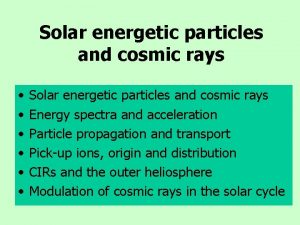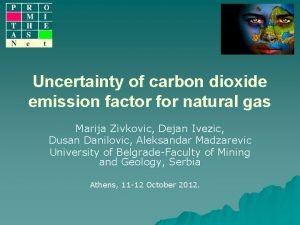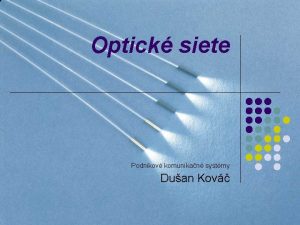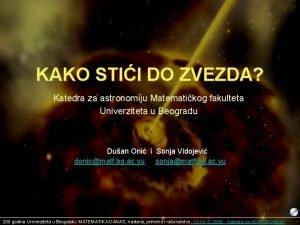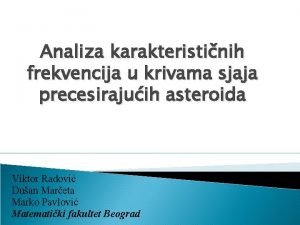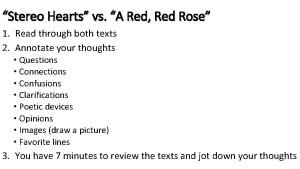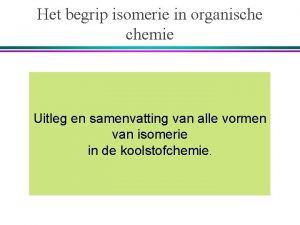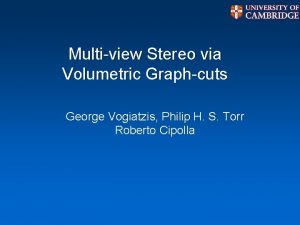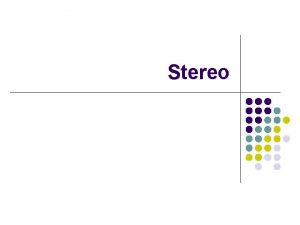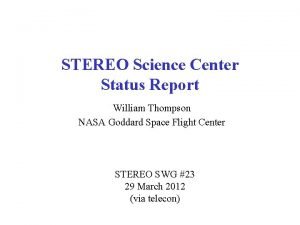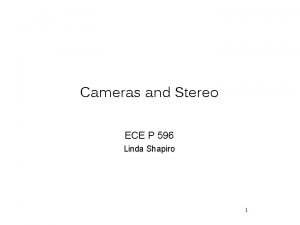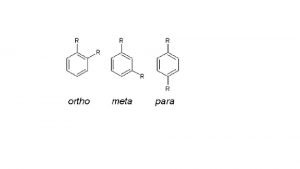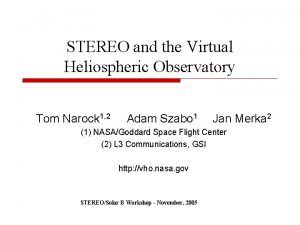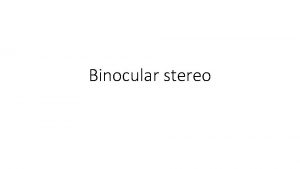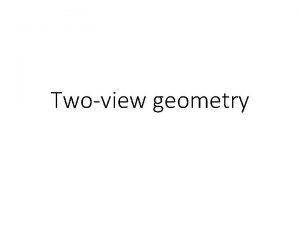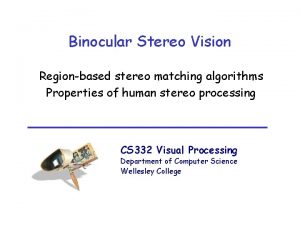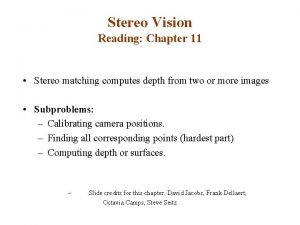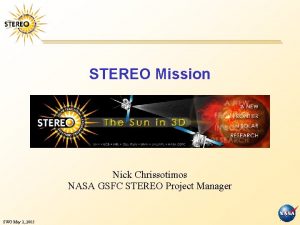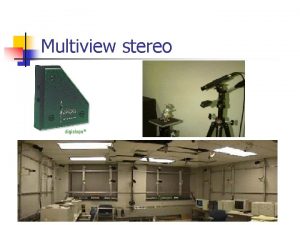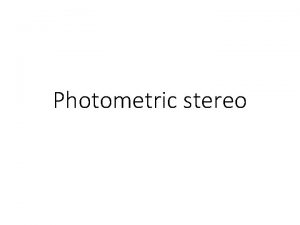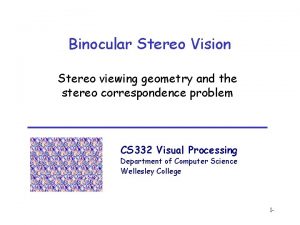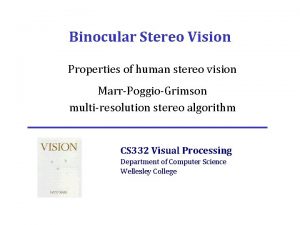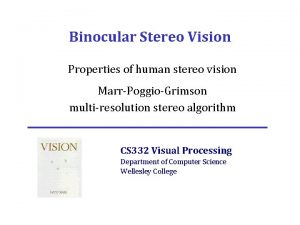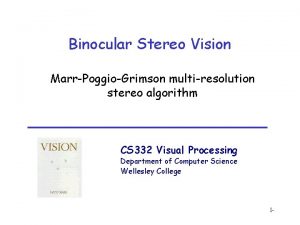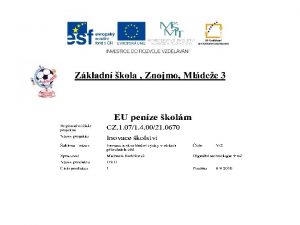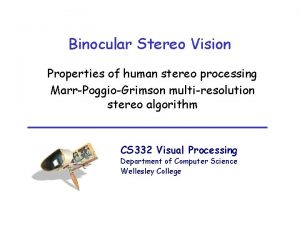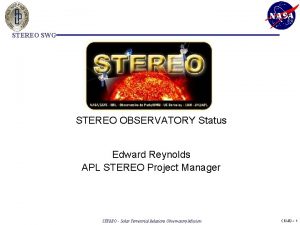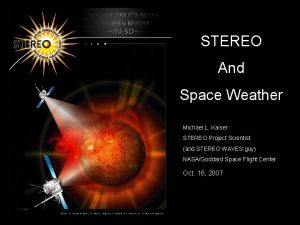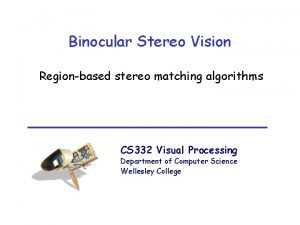State of NOAASECCIRES STEREO Heliospheric Models Dusan Odstrcil
















![Effect of Fast-Stream Position [ SAIC maps -- Pete Riley ] Case A 1 Effect of Fast-Stream Position [ SAIC maps -- Pete Riley ] Case A 1](https://slidetodoc.com/presentation_image_h2/02144a42623b97185b94d89b4ac9099b/image-17.jpg)

![Effect of Fast-Stream Evolution [ SAIC maps -- Pete Riley ] Case A 2 Effect of Fast-Stream Evolution [ SAIC maps -- Pete Riley ] Case A 2](https://slidetodoc.com/presentation_image_h2/02144a42623b97185b94d89b4ac9099b/image-19.jpg)






- Slides: 25

State of NOAA-SEC/CIRES STEREO Heliospheric Models Dusan Odstrcil University of Colorado/CIRES & NOAA/Space Environment Center STEREO SWG Meeting, NOAA/SEC, Boulder, CO, March 22, 2004

Collaborators § Nick Arge – AFRL, Hanscom, MA § Chris Hood – University of Colorado, Boulder, CO § Jon Linker – SAIC, San Diego, CA § Rob Markel – University of Colorado, Boulder, CO § Leslie Mayer – University of Colorado, Boulder, CO § Vic Pizzo – NOAA/SEC, Boulder, CO § Pete Riley – SAIC, San Diego, CA § Marek Vandas – Astronomical Institute, Prague, Czech Republic § Xuepu Zhao – Stanford University, Standford, CA Supported by AFOSR/MURI and NSF/CISM projects

Input Data • Analytic Models: - structured solar wind (bi-modal, tilted) - over-pressured plasma cloud (3 -D) - magnetic flux-rope (3 -D in progress) • Empirical Models: - WSA source surface - SAIC source surface - CME cone model (location, diameter, and speed) • Numerical Models: - SAIC coronal model (ambient + transient outflow)

Analytic Model – Distortion of ICME Study

Empirical model - Ambient Solar Wind

Numerical Model -- Magnetic Flux Rope Shock Model Interface Magnetic Leg Ejected Plasma Compressed Plasma

Ambient Solar Wind Models SAIC 3 -D MHD steady state coronal model based on photospheric field maps [ SAIC maps – Pete Riley ] CU/CIRES-NOAA/SEC 3 -D solar wind model based on potential and current-sheet source surface empirical models [ WSA maps – Nick Arge ]

CME Cone Model Best fitting for May 12, 1997 halo CME • latitude: N 3. 0 • longitude: W 1. 0 • angular width: 50 deg • velocity: 650 km/s at 24 Rs (14: 15 UT) • acceleration: 18. 5 m/s 2 [ Zhao et al. , 2001 ]

Boundary Conditions Ambient Solar Wind + Plasma Cloud

Latitudinal Distortion of ICME Shape ICME propagates into bi-modal solar wind

Evolution of Density Structure ICME propagates into the enhanced density of a streamer belt flow

Synthetic White-Light Imaging

Appearance of Transient Density Structure IPS observations detect interplanetary transients that sometime show two enhanced spots instead of a halo ring [Tokumaru et al. , 2003] MHD simulation shows a dynamic interaction between the ICME and ambient solar wind that: (1) forms an arc-like density structure; and (2) results in two brighter spots in synthetic images

Evolution of Parameters at Earth

May 12, 1997 – Interplanetary Shock Distribution of parameters in equatorial plane Evolution of velocity on Sun-Earth line 0. 2 AU 0. 4 AU 0. 6 AU 0. 8 AU • Shock propagates in a fast stream and merges with its leading edge 1. 0 AU

Case A 1 Case A 3 Fast-Stream Position [ SAIC maps -- Pete Riley ] Ambient state before the CME launch Disturbed state during the CME launch Ambient state after the CME launch
![Effect of FastStream Position SAIC maps Pete Riley Case A 1 Effect of Fast-Stream Position [ SAIC maps -- Pete Riley ] Case A 1](https://slidetodoc.com/presentation_image_h2/02144a42623b97185b94d89b4ac9099b/image-17.jpg)
Effect of Fast-Stream Position [ SAIC maps -- Pete Riley ] Case A 1 Case A 3 Earth : Interaction region followed by shock and CME (not observed) Earth : Shock and CME (observed but 3 -day shift is too large)

Case A 2 Case B 2 Fast-Stream Evolution [ SAIC maps -- Pete Riley ] Ambient state before the CME launch Disturbed state during the CME launch Ambient state after the CME launch
![Effect of FastStream Evolution SAIC maps Pete Riley Case A 2 Effect of Fast-Stream Evolution [ SAIC maps -- Pete Riley ] Case A 2](https://slidetodoc.com/presentation_image_h2/02144a42623b97185b94d89b4ac9099b/image-19.jpg)
Effect of Fast-Stream Evolution [ SAIC maps -- Pete Riley ] Case A 2 Earth : Interaction region followed by shock and CME (not observed) Case B 2 Earth : Shock and CME (observed but shock front is radial)

Evolution of Parameters at Earth

Remote Access Client Server ENKI -- web ENKI Coronal Data (on MSS) IDL procedures Input Data (on PTMP) ENLIL – Fortran/MPI/Net. CDF Vi. Server A/A – Java/VTK Output Data (on PTMP) web CDP Archive Data (on MSS)

ENKI – Interface to ENLIL

ENKI – Interface to ENLIL

Remote Visualization: ENKI--IDL Preview of data before downloading processing and visualization, archiving, etc. Plot 1 -D profiles and 2 -D contours or surfaces of 1 -D, 2 -D, or 3 -D data

Interplanetary Disturbances
 Heliospheric current sheet
Heliospheric current sheet Dušan dušek kufor na sny rozbor
Dušan dušek kufor na sny rozbor Dvere do kľúčovej dierky
Dvere do kľúčovej dierky Dusan danilovic vanderbilt
Dusan danilovic vanderbilt Dusan padek
Dusan padek Astronomija fakultet
Astronomija fakultet Dusan kalasek
Dusan kalasek Dušan mitana
Dušan mitana Dusan marceta mehanika
Dusan marceta mehanika Dušan dušek rýchlik
Dušan dušek rýchlik What is the difference between models and semi models
What is the difference between models and semi models Tcp stereo
Tcp stereo Stereo hearts and a red red rose answers
Stereo hearts and a red red rose answers Dichloor
Dichloor Stereo isomerie
Stereo isomerie Would you mind turning your music down
Would you mind turning your music down Know the lingo worksheet answers
Know the lingo worksheet answers Multiview stereo
Multiview stereo Would you mind turning down the tv
Would you mind turning down the tv Fusion stereo problems
Fusion stereo problems Stereo science center
Stereo science center Lun shape
Lun shape Stereo
Stereo Stereo luz fm tehuacan
Stereo luz fm tehuacan Stereoisomeria
Stereoisomeria 11 stereo
11 stereo
